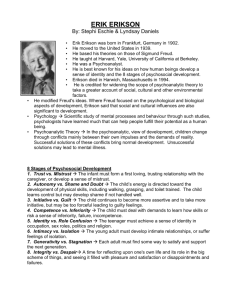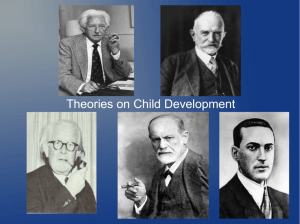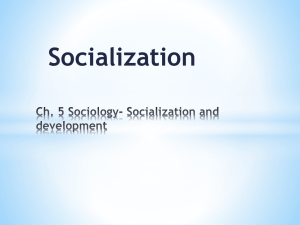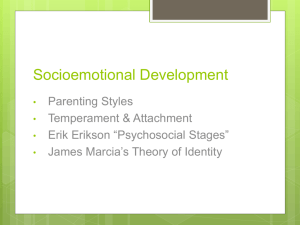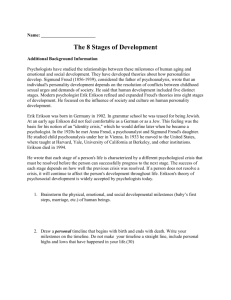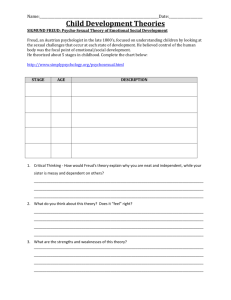09-10SOCCHP5SOCIALIZATION - sociology1-2
advertisement
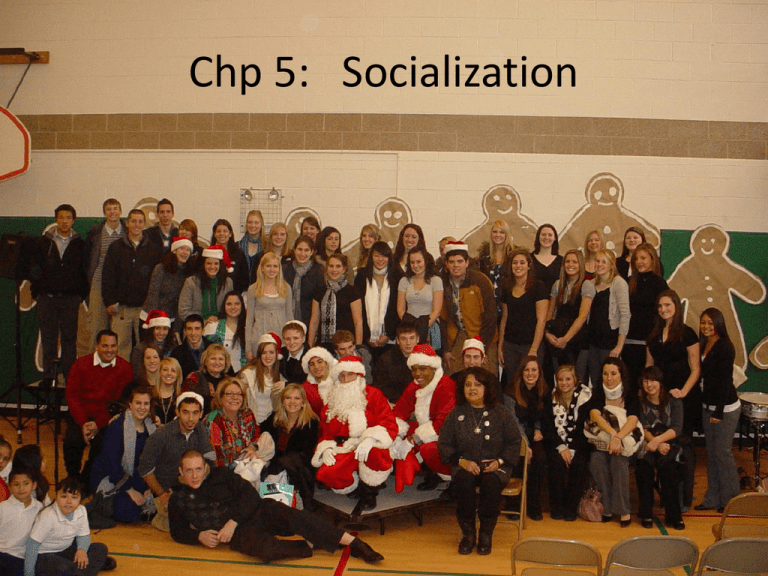
Chp 5: Socialization SOCIALIZATION • Socialization refers to the lifelong social experience by which individuals develop their human potential and learn culture. • HUMANS, unlike other living species, need social experience to learn their culture and to survive. • PERSONALITY : A person’s fairly consistent patterns of acting, thinking and feeling. Personalities are built by taking in our surroundings. Charles H. Cooley – Looking Glass Self • Humans represent a mirror (which people used to call a “looking glass”) in which they see themselves. • What we think of ourselves, then, depends on what we think other think of us • Ex: “you’re smart, you’re clever, you’re beautiful” • Development of self-image based on how we “THINK” others see us HUMAN DEVELOPMENT: NATURE vs. NURTURE Biological sciences : The Role of Nature Charles Darwin – study of evolution explained that each species evolves over thousands of generations as genetic variations improve its ability to survive and reproduce – people have instinctive “human nature” – i.e. “born” criminals? HUMAN DEVELOPMENT: NATURE vs. NURTURE Biological sciences : The Role of Nurture Social Scientists are careful about describing any HUMAN BEHAVIOR as INSTINCTIVE – because human life depends on the functioning of the body – children share biological traits and that heredity plays a part HUMAN DEVELOPMENT: NATURE vs. NURTURE Without denying the importance of nature, NURTURE matters more in shaping human behavior….. So, nurture is our nature…. ex: whether a person realizes any inherited potential depends on an environmental factor – having an opportunity to develop it. George Herbert Mead - Developed a theory of SOCIAL BEHAVIORISM to explain how social experiences creates individual personality. Like John B. Watson, Mead believed environmental factors to be extremely POWERFUL in shaping behavior Mead studied inward thinking, humanity’s defining trait MEAD - The SELF - The first component and central component is the SELF: part of the individual’s personality composed of self-awareness and self-image. - Mead claims the SELF develops with social experiences. Unlike Freud, Mead rejected the position that personality is guided by biological drives - MEAD said SELF develops only as the individual interacts with others. MEAD - The SELF - In the absence of interaction, as we see from cases of isolated children, the body grows, but no self emerges. - SOCIAL EXPERIENCE is the EXCHANGE of SYMBOLS. Humans find meaning in action by imagining people’s underlying intentions. MEAD - The SELF - Understanding intention requires imagining the situation from the other’s point of view. - Social interaction, then, involves seeing ourselves as others see us – a process that involves TAKING the ROLE of the OTHER. MEAD –The I and the ME - By taking the ROLE of the OTHER, we become SELF-AWARE - Mead says the self has two parts: The self is active and spontaneous - The active side of the self is the “I” - The self is also an OBJECT – as we imagine ourselves as others see it – the objective form is the “ME” - MEAD –The I and the ME - All social experience has both components: - WE INITIATE AN ACTION (the I-phase of self) and then we continue the action based on how others respond to us (the me-phase of self) MEAD – The Development of the Self - The key to development the self is learning to take the role of the other. IMITATION (infants mimic) PLAY (taking the role of significant others) GENERALIZED OTHER – widespread cultural norms and values we use as a reference in evaluating ourselves. JEAN PIAGET: Cognitive Development - SENSORIMOTOR (0-2) Infants explore their world through their senses and motor activities. They touch, hear, smell, grasp, suck, and shake objects. Object permanence and emotional attachments to a few important people form. JEAN PIAGET: Cognitive Development - PREOPERATIONAL (2-7 YEARS) Pre-LOGICAL Children learn language to represent objects and begin to use pretending and thinking about things they cannot see. They are egocentric (self-centered) at this stage, seeing things only from their own perspective. JEAN PIAGET: Cognitive Development CONCRETE OPERATIONAL (7-11 YEARS) Logical reasoning develops, but is very concrete and linked to objects they can see. They learn to add and subtract and figure out the principle of conservation – physical properties of objects (weight, volume) are the same (conserved) even if appearance (form, shape) changes. JEAN PIAGET: Cognitive Development FORMAL OPERATIONAL (12 YEARS to ADULT) Abstract thinking develops. Concept are manipulated and problem solving is thought out in advance. Historical time can be understood. Adolescents are cognitively CAPABLE of such thinking, but some adults do not become fully formally operational. ERIK ERIKSON’s STAGES of PSYCHOSOCIAL DEVELOPMENT STAGE – AGE Infancy 0-1 CRISIS to RESOLVE Infants depend on others and learn to trust that their needs will be met; otherwise become fearful, mistrusting their environment. ERIK ERIKSON’s STAGES of PSYCHOSOCIAL DEVELOPMENT STAGE – AGE Toddler 2-3 CRISIS to RESOLVE Autonomy vs. Shame /Doubt Children learn to do things on their own and control their behavior. Encouragement and consistent discipline builds self-esteem and protects them from shame and humiliation ERIK ERIKSON’s STAGES of PSYCHOSOCIAL DEVELOPMENT STAGE – AGE CRISIS to RESOLVE Early Childhood 3-5 Initiative vs. Guilt Exploration, role-playing and inquisitiveness are invited by parents, if not, children feel guilty when they initiate new behaviors. ERIK ERIKSON’s STAGES of PSYCHOSOCIAL DEVELOPMENT STAGE – AGE CRISIS to RESOLVE Elem School 6-12 Industry vs. Inferiority Children need recognition in school and at home for achievements and support for failures; otherwise feelings of inadequacy result. ERIK ERIKSON’s STAGES of PSYCHOSOCIAL DEVELOPMENT STAGE – AGE CRISIS to RESOLVE Adolescence 13-19 Identity vs. Role Confusion Young people deal w/ sexual maturity and impending adult roles. They must integrate previous experiences to develop a sense of personal identity. Without an identity compatible with who they believe they are, role confusion occurs. ERIK ERIKSON’s STAGES of PSYCHOSOCIAL DEVELOPMENT STAGE – AGE CRISIS to RESOLVE Young Adult 20 + Intimacy vs. Isolation A strong personal identity helps develop the intimacy needed for commitment to others, such as a spouse/significant other; otherwise a person can become lonely and isolated. ERIK ERIKSON’s STAGES of PSYCHOSOCIAL DEVELOPMENT STAGE – AGE CRISIS to RESOLVE Mid-Adulthood 40+ Generativity vs. Stagnation Career, marriage, relationships and children are central. Contributions to the next generation occur. Value is placed on what he/she is doing for others, otherwise, a person is resigned, unproductive, and may feel worthless. ERIK ERIKSON’s STAGES of PSYCHOSOCIAL DEVELOPMENT STAGE – AGE CRISIS to RESOLVE Late Adulthood 65+ Integrity vs. Despair A life review finds meaning or lack of it in accomplishments. Was life worthwhile or full of disappointments and failure? ERIK ERIKSON As people move through the LIFE CYCLE, continuing SOCIALIZATION occurs. Erikson’s work serves as a vital sociological link in understanding continuing socialization!!! SIGMUND FREUD (1856-1939) The work of Freud has had profound impact on the social sciences. According to Freud, humans have basic BIOLOGICAL NEEDS or DRIVES that conflict with one another. BIOLOGY is an important part of human behavior, but unlike animals who exist solely on inborn traits, humans have only a few general (but powerful) instinctive forces. Freud’s model of personality is built around this class of forces. FREUD’s MODEL HAS 3 PARTS 1st - ID The ID is Freud’s term for an individual’s biological drives and impulses; this id is selfish, irrational, ever-striving for pleasure and gratification, and it is UNCONSCIOUS. Ex: Newborns are totally id-driven FREUD’s MODEL HAS 3 PARTS 2nd - SUPEREGO Since parents/care givers, etc must inevitably begin to say no to young children, the unsocialized drives propelled by the ID come into conflict with another part of the personality, the SUPEREGO - This is Freud’s term for all the NORMS, VALUES and MORALS that are LEARNED through socialization. These form the demands of society and are internalized as a person’s conscience. FREUD’s MODEL HAS 3 PARTS 2nd - SUPEREGO CONTINUED….. For successful socialization, the ID must be controlled, and it is the task of the superego to do so. Since pleasure / gratification are always lurking in the unconscious, the road to the socialized personality is not an easy one. FREUD’s MODEL HAS 3 PARTS 3rd - EGO The EGO acts as a mediator between the biological drives and the society that would deny them. The EGO is largely conscious and reality-based, which means it provides rational plans to get what the individual wants, but in a socially acceptable way.
